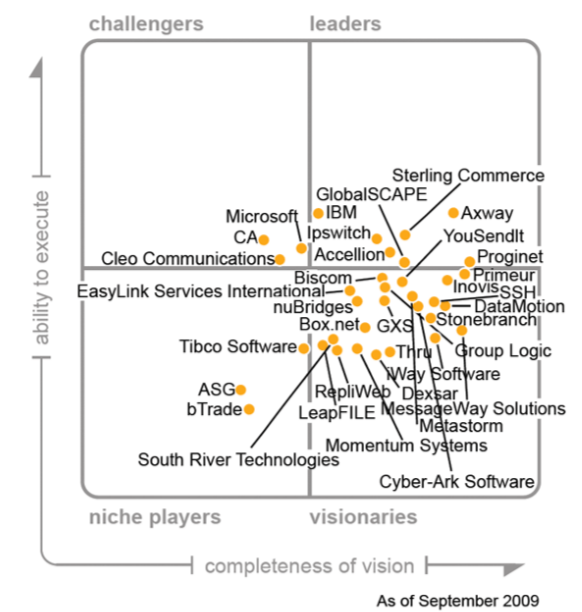
Gartner are globally known for their research reports, so it’s no surprise that enterprises still canvas their opinion when considering a new Managed File Transfer (MFT) solution. However, many years have passed since Gartner’s Frank Kenney, someone I’ve got to know well over the years and very much respect his opinions on all things file transfer, focused on this sector and somewhat unbelievably it has been 15 years since the release of the Gartner Managed File Transfer Magic Quadrant.
When it was released it gave many vendors with whom we now work, a new phrase to represent or categorise their software: Challenger, leader, niche player or visionary.
Fifteen years is a long time in any marketplace but in enterprise software, where things move rapidly, it is a lifetime. What was true when the original report was written, has been drastically re-written, and if Gartner were to rewrite their Gartner Managed File Transfer Magic Quadrant the list of vendors would be considerably different.
Today MFT falls under the broader spectrum of integration at Gartner, and in wanting to better understand their appreciation of the space, Pro2col became a Gartner client providing us the opportunity to speak with each of the three analysts covering MFT. Pro2col learned that Gartner no longer cover the MFT industry, providing our team the opportunity to update them on the sector. Even their Gartner Market Snapshot of Managed File Transfer is outdated and encompasses vendors that may not strictly fall under the MFT category.
If you’re short on time and want to understand what the latest position is regarding MFT software, you can review our comprehensive, comparative analysis of the current vendors in our report of the ‘Top MFT Software Tools to Consider in 2024’. It details the top 15 vendors, providing key facts, advantages, considerations, and features of their MFT software solutions.

Gartner’s Managed File Transfer Magic Quadrant comprised of a collection of vendors with products which had file transfer capabilities but wouldn’t meet today’s classification of an MFT tool. It included a variety of solutions which would fall into the category of Enterprise File Sync & Share (EFSS) also known as Content Collaboration Portal (CCP), and tools that have become better known as Secure Email or Ad Hoc file sharing.
Of the thirty-five vendors listed only twelve of them are considered Managed File Transfer vendors by today’s classification, another ten are now End of Life (EOL) with no software updates for a minimum of two years. Another seven vendors fall into the EFSS and Ad Hoc file sharing categories, with the remaining six vendors having limited file transfer capabilities.
So, what’s happened to those represented in the Gartner Managed File Transfer Magic Quadrant of 2009? Below is our summary.